This is a Ricoh 519M 35mm rangefinder made by Riken Optical Industries Co., Ltd, which first went on sale in 1959. It is an evolution of the earlier Ricoh Five-One-Nine which was a very similar camera, except without a built in meter. The Ricoh 500-series cameras were very well built, offered excellent optics, and had a unique bottom mounted “trigger” film advance that was thought to be faster than a traditional wind lever. The camera was not in production for very long and is very rare today.
Film Type: 135 (35mm)
Lens: 4.5cm f/1.9 Rikenon coated 6-elements
Focus: 3 feet to Infinity
Viewfinder: Coincident Image Coupled Rangefinder
Shutter: Seikosha SLV Leaf
Speeds: B, 1 – 1/500 seconds
Exposure Meter: Uncoupled Selenium Cell w/ top plate readout and LVS
Battery: None
Flash Mount: Hot Shoe and M and X Flash Sync
Manual (similar model): https://mikeeckman.com/media/Ricoh519Manual.pdf
History

Ricoh Company, Ltd. is the name of a multinational company making products in a variety of industries in over 180 countries, whose headquarters are in Tokyo, Japan. One of Ricoh’s child companies is Ricoh Imaging Company Ltd. who is the current maker of Pentax brand DSLR and Ricoh point and shoot cameras.
The current Ricoh company was founded in 1936, but there was a separate company named Rikagaku Kenkyūjo (in English: Physico-Chemical Research Institute) that started in 1917 as a chemical apparatus institute who researched and developed a variety of products, including chemicals used during the manufacture of photographic film. In their earlier years, Rikagaku Kenkyūjo was only a research institute that didn’t actually sell anything in the open market, but in 1926 they changed their name to Rikagaku Kōgyō K.K. and began to market the products developed by the institute.
Rikagaku Kōgyō K.K. products were used in all areas of Japanese manufacturing, but in February 1936, the photographic paper division branched off into it’s own separate company and was known as Riken Kankōshi K.K. The name “Riken” was chosen as an abbreviation to the company’s original name RI-kagaku KEN-kyūjo.
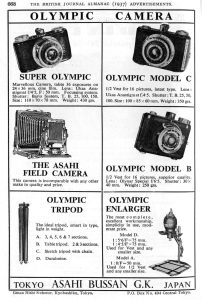
A year after it’s foundation, Riken would purchase another Japanese company called Asahi Bussan G.K. who had previously manufactured a 35mm leaf shutter camera known as the Olympic. The Olympic, and a higher spec model known as the Super Olympic would be Riken’s first cameras manufactured under their name. Together with their photographic chemicals division, along with their new ability to make cameras, Riken quickly became one of Japan’s premiere photo companies.
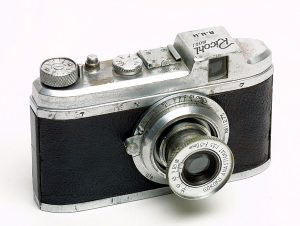
In 1938, the company would change it’s name once again to Riken Kōgaku Kōgyō K.K., or in English, Riken Optical Industries Co., Ltd, a name which the company would be known by until 1963. This same year, Riken would introduce it’s first camera completely designed in house, known as the Riken No. 1 which was a solid bodied camera that took 3×4 images on 127 roll film.
The Riken No. 1 was sold under a variety of names, one of which was the Ricohl, the first appearance of the name “Ricoh” in one of Riken’s products. The Riken No. 1 has a very complicated history that has it’s very own Wikipedia page which I encourage you to read if you want to know more.
Around the start of the war, Riken would produce a variety of cameras including a 6×6 TLR known as the Ricohflex. The Ricohflex would be one of Riken’s earliest successes, launching a whole line of Ricohflex TLRs that were in production from 1939 until at least 1954.
Until the early 1950s, all Riken products used either 120 or 127 roll film making them one of the few Japanese companies to avoid the 35mm market. In 1953 after merging with yet another Japanese company called Asahi Seimitsu, Riken would release their first ever 35mm camera, a modest model called the Ricolet. The Ricolet was a compact viewfinder camera with a basic 3-element Ricoh Anastigmat lens and a 3-speed shutter.
Two years later, the Ricolet would be upgraded and released as a new model, simply called the Ricoh 35. Using the same basic body and 3-element lens, the Ricoh 35 would receive two notable upgrades. The first was a coincident image coupled rangefinder, but the second would be an all new “trigger”‘ film advance system that used a folding linkage on the bottom of the camera where the photographer would use his or her left index finger to advance the film, via a squeezing, or gun-trigger motion.
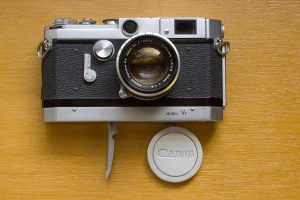
Although bottom wind levers were not unique as Kodak had employed a bottom wind lever on their Retina series, it was the first appearance of such a trigger wind lever. Canon and the Soviet company KMZ would release the Canon VT and Drug 35mm cameras shortly after the Ricoh employing this same feature. Although it was a short lived feature by other companies, Ricoh would continue to release trigger wind cameras into the early 1960s, perhaps as a way to stand out in the market.
Starting with the Ricoh 35, Riken would release a variety of new models, improving on previous models through the end of the 1950s. First was the Ricoh 35 Deluxe, which had an improved 5-element Ricoh lens and 6-speed shutter, then the Ricoh 500 Deluxe which further upgraded the shutter, added flash synchronization, and a Light Value Scale, then the top of the line Ricoh Five-One-Nine Deluxe which came with a 6-element f/1.9 Rikenon lens.
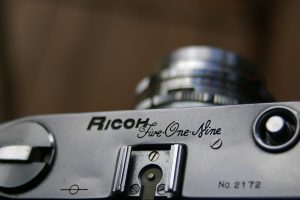
The Ricoh Five-One-Nine Deluxe was a very well built all metal camera with a bright and easy to use coupled rangefinder, a fingertip focus system, an excellent 6-element lens, and the previously mentioned trigger film advance. Although a very well built camera, it was a relative bargain compared to quality German and Japanese rangefinders selling for $99.95 in 1958. This translates to $843 today which isn’t exactly pocket change, but it was a huge bargain compared to what the competition was offering.
The Five-One-Nine was often sold with a clip on selenium light meter that would attach to the hot shoe on top of the camera and would use the same LVS numbers found on the lens. Although a popular accessory, attaching it to the top of the camera increased the overall size of the camera, making it less appealing as other models that had a built in meter.
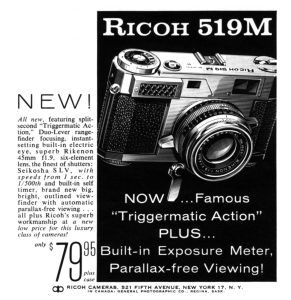
As a result in 1959, a slightly revised model called the Ricoh 519M was released that had the same coincident image rangefinder, trigger wind film advance, f/1.9 lens, but included an uncoupled selenium meter inside the main body of the camera. According to one site, the 519M was sold for export only, suggesting it was not available in Japan. Strangely, despite being an “upgrade” to the original Five-One-Nine, the 519M was sold for $79.95 in 1959. Perhaps this was done as a move to encourage more people to buy Ricoh cameras at a time when the industry was largely moving away from rangefinders, or perhaps they just found a way to make them cheaper. In any case, the 519M was a huge bargain at the time.
The 519M was produced for a very short period of time, probably about a year as I could find no reference to it in any of the early 1960s photo catalogs or magazines using Google’s reference library.
My only guess is that although Ricoh’s cameras were physically and optically as good as anything else out there, they fell victim to the overly crowded Japanese camera industry of the late 1950s. Other great camera makers like Aires, Miranda, and Neoca would eventually fail, not because of poor products, but merely because the competition was so fierce.
Riken would eventually change it’s name to Ricoh in 1963 adopting the name of it’s most successful product. Ricoh would continue to make 35mm SLR cameras using the M42 screw mount and eventually the Pentax K-mount well into the 1980s. The company would never regain it’s reputation as a leader in the Japanese camera industry, but obviously did enough to stick around as the company still exists today.
Today, the late 1950s Ricoh rangefinders have a modest following with collectors. The most obvious being the Ricoh Five-One-Nine which seems to have been the most common model. The 519M generally isn’t sought after quite as much, most likely due to lack of knowledge of it. Comparing the 519M to other cameras of the period, the build quality is extremely high. There is absolutely nothing in this camera’s construction that suggests it was a cheap model. With my knowledge of what products were available in the late 50s when this camera was made, it seems like it should have been competitive, but it seems that wasn’t the case. Whatever the reason for the 519M’s short production run, I think it’s a very nice model that is absolutely worthy of inclusion into any collection.
My Thoughts
Early in my days as a collector, I had become aware of the Ricoh Five-One-Nine and thought it’s bottom wind trigger advance and good looks made for a desirable camera, but this model has the right balance of demand and lack of availability that when one goes up for sale, the prices remain a bit higher than I am comfortable with. As a result, the Five-One-Nine remained a stalwart of my wish list.
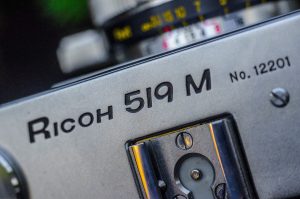
So it came as a surprise one day when I saw this 519M for sale with no bids at the low, low opening bid of $20 and as I usually do, I threw out what I call a mercy bid on it. Mercy bids are when you put a low bid on something but don’t realistically think you’ll win, but also couldn’t sleep at night knowing that you didn’t at least take a chance. I’ve had mercy bids on Rolleiflexes, Leicas, and other high dollar cameras, and as you might imagine, they never amount to anything. A mercy bid of $50 on a Rollleiflex usually pales to the $200 winning bid that someone else is willing to pay.
At the time, I gave myself a “not in this lifetime” chance of winning the 519M, but to my surprise, later that day when I checked my account and saw that I was the only bidder on this camera and took it home for the opening bid of $20, I had to pinch myself to see if I was dreaming (yes, sometimes I dream about winning cameras on eBay).
When it arrived, my elation grew as I was amazed to see that the camera was in near mint condition. Why did this camera go unnoticed by what I can only assume were hundreds or even thousands of GAS inflicted people like myself? Was it the relative obscurity of this particular model, or was it the seller’s poor description, or was I just lucky? Perhaps a little bit of all three.
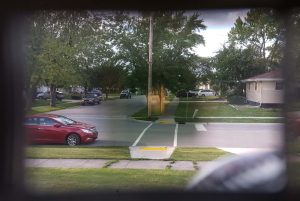
The Ricoh 519M is a handsome camera. It is a heavy and solid metal camera that predates the widespread use of plastics and other weight saving materials. The viewfinder is large, bright, and very easy to use. The rangefinder patch is surrounded by a darker patch which helps increase contrast between the coincident image which helps make it easier to see, especially in low light. Strangely, there are no projected bright lines indicating the 4.5cm frame like I expected there to be.
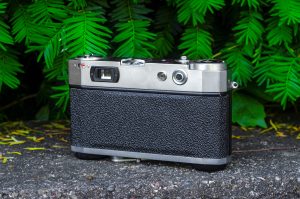
The back of the camera has a couple features that aren’t normally located there on other cameras. The first is the frame counter, which is in a small window to the left of the viewfinder. The first time I saw this, I thought it was kind of odd, but then I thought, what better place to get instant feedback for how many shots you have left, than right next to where your eye needs to be most of the time?
To the right of the viewfinder is the PC flash sync port. I don’t think I’ve ever seen another camera with this port on the back of the camera like this. Although I never use sync ports, I have seen the connectors they require and they generally stick out a little bit, and I would think that with this camera to your face, the wires might hit your forehead.
Lastly, is the large rewind button. When I first saw this button, I wondered what it could be. It is prominently located on the back of the camera with a large chrome trim piece and is even covered in a small dot of leatherette. It is clear that Riken really wanted people to notice the rewind button, otherwise they wouldn’t have drawn so much attention to it!
Of course the signature feature of the 519M is the bottom mounted “trigger” film advance. This style of film advance was something that only a few companies ever offered. Ricoh had it on quite a few of their cameras, but Canon also offered it for a short while on their full sized rangefinders and the earliest Canonets. It must have been a bit of a fad in the mid to late 50s to offer this style of film advance over the more traditional “swing out” method employed by almost everyone else.
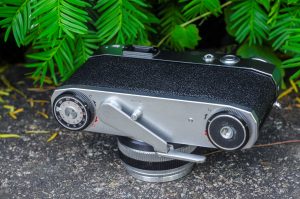
Prior to handling this camera, I never really understood the appeal of a trigger advance, or how it even worked. What threw me the most was that I never realized it was meant to be used with your left hand. In all of the pictures I saw, I thought it was something you used with your right hand, but the idea is that most of the time, your left hand supports the lens and the bottom of the camera. Naturally, most people have at least one or two fingers from their left hand either on the bottom of the lens or the bottom of the camera. This is exactly where the folding trigger is. The trigger can be activated with a single finger, but I found that I liked to use both my index and middle fingers. In the video below, you can see me wind and fire the shutter three times. In use, I find this arrangement to be extremely comfortable.
The theory of a trigger advance is that it is faster and can be done without taking the camera away from your eye. Ricoh claims that with practice you could advance the film and fire off a shot at a rate of 2 frames per second if you so wish. Did anyone back then need to shoot at 2 frames per second? I can’t really be sure, but that was how it was marketed. By the early 1960s, it seems that the trigger advance fell out of favor by everyone, including Ricoh. In fact, it would seem that all bottom wind cameras like the Kodak Retina would eventually disappear. Was it because there was something fundamentally wrong with them, or that the general public didn’t seem to really care enough to support their continued availability? I can’t be sure. In either case, the trigger wind system remains a very curious (and neat) brief history in the evolution of camera design.
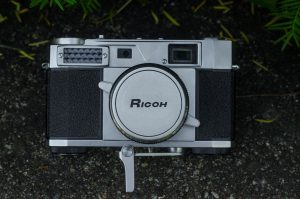

The appeal of the Ricoh 519M extends beyond the trigger advance. I also found the “paddle” style focus control on opposing sides of the lens to be comfortable and easy to use. With the camera to your eye, you can easily change the focus of the camera with your fingertips on either hand. I actually found that I could easily change focus using the middle finger on my right hand.
In some ways, the Ricoh 519M is a “fingertip” camera. At any given point, I had two fingers from my left hand on the trigger, my right index finger on the shutter release, and my right middle finger on the focus paddle. Reading this out loud, it probably sounds overly complicated and cumbersome, but in use, I got used to it very quickly.
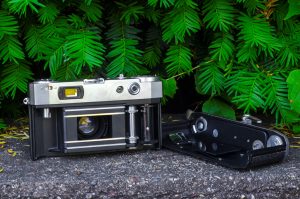
Loading film into the camera is a mostly uneventful process. To open the camera, there are two round knobs on the bottom of the camera that need to be turned to the Open position, and then the entire bottom and back of the camera comes off. There is no hinge on the 519M. This is likely due to the way in which the bottom wind lever attaches to the linkage inside of the camera. Once the back is off, a new film cassette loads on the left side of the camera and stretches to the takeup spool on the right.
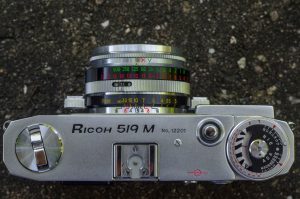
On the top plate of the camera is the rewind knob, flash hot shoe, shutter release, and meter readout. Ricoh cameras of this era all have a similar looking hot shoe with a white plastic isolator in between a small metal dot which is the flash sync point. It looks close enough to a modern SLR’s hot shoe, but does it work a modern flash?
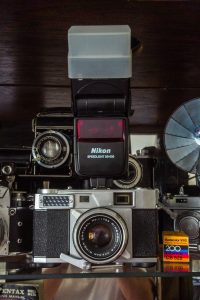
Yep! I mounted my Nikon SB-600 Speedlight to the Ricoh and turned it to manual mode and test fired the camera and the flash responded every time. Of course, things like TTL flash metering and the flash’s zoom control won’t work, but still, it’s pretty cool to think that a flash that I use on my Nikon DSLR can also be used on a camera made in 1959! Even cooler, when set to “X” flash sync, the Ricoh 519M can flash sync at the shutter’s fastest speed of 1/500, something my Nikon DSLR cannot do.
I particularly love the feel of the shutter release on this camera. The button is solid metal and has a nice rounded top to it that is slightly recessed into the plate and feels comfortable under your finger.
The meter is a standard uncoupled selenium meter as was common on most metered cameras from the 1950s. To use the meter, you would first rotate the outer dial to match the film speed loaded in the camera and then take a reading of whatever LV (Light Value) number the meter is pointing to. Using the coupled aperture and shutter speed dials on the lens, you would turn them until a corresponding LV number is lined up with the marker.
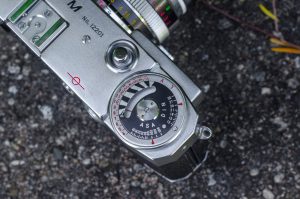
I have spoken many times on this site of my love/hate relationship with coupled LV systems on other cameras. Some companies like Yashica and Minolta did them well, others like Kodak, Aires, and Flexaret make them cumbersome and difficult to overcome. Thankfully, Ricoh’s system is more like the ones used by Yashica and Minolta in that you can change either shutter speed or aperture manually and easily override a chosen LV number. There is no need to make a separate motion, or lift up on some pin to disengage the coupling like on the Kodak Retina IIc or Flexaret VII.
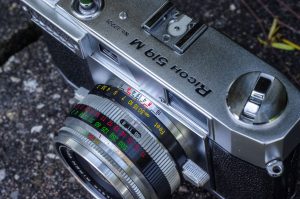
This type of system predates the coupled meter or match needle systems that would quickly become common in the 1960s and 1970s, but when done well, a LV system can be just as easy to use in my opinion. During my first roll through the 519M, I chose to use the meter for about half of the roll and went Sunny 16 for the rest.
Between the excellent viewfinder, the unique trigger film advance, and convenient focus paddles, I can declare the Ricoh 519M as an ergonomic champion. Almost every design element of the camera is done really well and improves the shooting experience in ways I didn’t think cameras needed to be improved upon. I really enjoyed shooting the Ricoh 519M and nothing short of complete failure will keep this from being one of my all time favorite cameras.
My Results
You can always tell how excited I am about a camera based on how quickly I can get through a roll of film. In the case of the Ricoh 519M, it took me only a day to shoot an entire roll of Fuji 200 on a hot summer day at a parade and carnival. I thoroughly enjoyed the process of using the camera, but would my enthusiasm for the camera itself live up to the results?
A resounding yes! This was a camera I felt so strongly about, that I trusted the meter and made several daring attempts at shooting near dusk in very low light to extreme success. Each of the last 4 shots in the gallery above were shot either at sundown, or very near to it. The one in particular of the carnival over the lake is done a good 15 minutes past sunset. I stabilized myself on top of a garbage can and trusted the meter readout which suggested 1/15 second with the lens almost completely wide open.
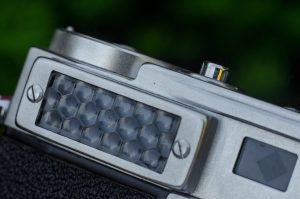
The Ricoh 519M is one hell of camera that is good looking, has several unique and innovative controls that improve the shooting experience, and is capable of stunning images. Normally, I would include a few “yeah but” nitpicks, but I have to really try to come up with one. If I absolutely had to come up with one thing it’s that the selenium meter looks to be a bit of an afterthought in it’s location on the front of the camera. If Ricoh had figured out a way to incorporate the meter in the main body housing, it would have improved the looks ever so slightly.
But seriously, that’s it. The meter looks a little goofy, otherwise this is a top 10 camera for me and one that I am sure will be in regular rotation when I am looking for a quality rangefinder for spontaneous and candid photos! Although I do not own a Ricoh Five-One-Nine and know that the two cameras are basically the same, just without the meter, I think I still prefer the 519M to the meterless model.
Sadly, the 519M was made in extremely limited numbers for a very short period of time. I almost never see these for sale and as such can be very hard to find. The fact that I got this one in such excellent condition is likely not something that will be easily repeatable. But if one ever shows up for sale for anything resembling a good price, you would be foolish to pass it up as this is an excellent camera!
My Final WordHow these ratings work |
The Ricoh 519M was a short lived, but very well built rangefinder with an excellent f/1.9 lens, clever trigger film advance, and easy to use paddle controls on each side of the lens. Every control of the camera was carefully thought out from the shutter release button to the implementation of the LVS system. It is an extremely easy to use camera that is solid and feels very well built in your hands. I loved using mine and it has quickly become one of my favorite cameras. While I have never been a huge fan of bottom wind cameras like the Kodak Retina, I love the trigger advance. These cameras are not common, but if one becomes available for a good price, I strongly recommend picking one up. | ||||||
| Images | Handling | Features | Viewfinder | Feel & Beauty | History | Age | |
| 2 | 2 | 1 | 2 | 2 | 0 | 20% | |
| Bonus | +1 for overall awesomeness, the complete package | ||||||
| Final Score | 11.8 | ||||||
Additional Resources
http://www.asahi-net.or.jp/~rd2h-ari/RI_519M.htm
http://quirkyguywithacamera.blogspot.com/2017/06/spell-it-out-ricoh-fiveonenine.html
https://www.photo.net/discuss/threads/number-please-calling-ricoh-five-one-nine.374772/
http://www.collection-appareils.fr/x/html/camera-2999-Ricoh_519%20M.html

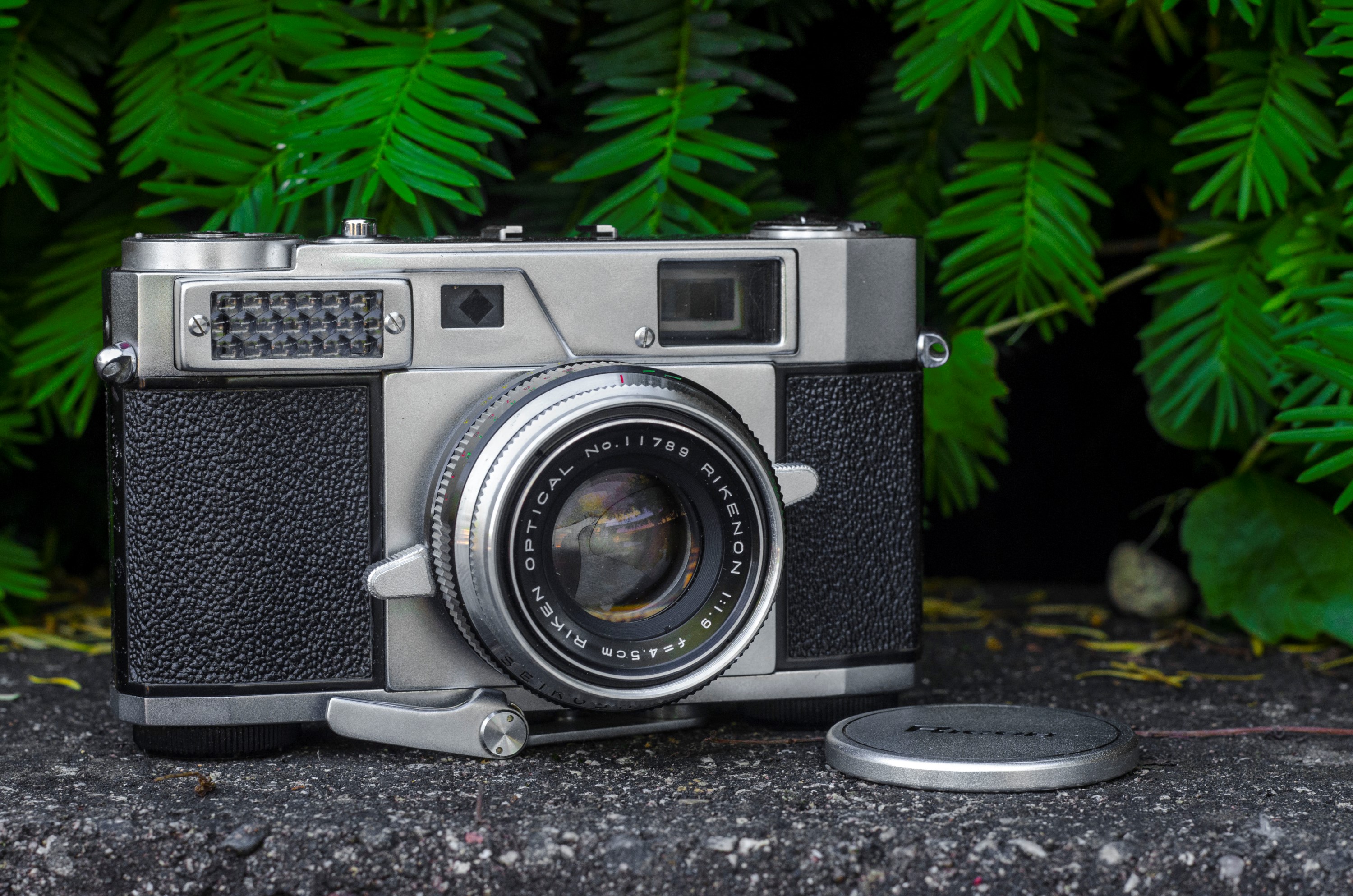
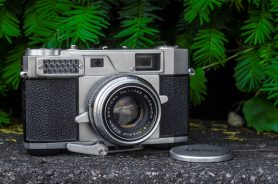
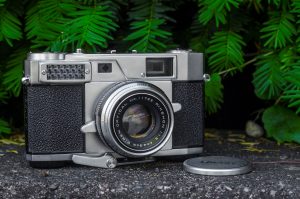








Mike, the meter on the 519M was designed to be removed and cleaned from time to time. Ricoh’s M42 lenses are still in demand. Ricoh did not want to compete with the Big 3 (Nikon, Canon, Olympus) so they put their resources into their TOP QUALITY ($$$) line of OFFICE COPIERS using their same lens technology. I have a Ricohflex (Dia L) and their lenses are the equal of – if not better than – than most other TLRs of the day. Still a very underrated TLR.
I was lucky to purchase a Ricoh 35 DeLuxe with the unheard-of 45mm f2.0 Rikenon lens. This camera is virtually identical to the Five One Nine and the 35 DeLuxe with the f2.8 lens. The lens’ serial number is 1399, which strikes me as a low figure. Some folks speculate that the f2.0 and f1.9 Rikenons are Tomioka products, and their vintage supports this idea. I just finished shooting a roll of Film Photography Project’s RetroChrome 320 which is now enroute to The Darkroom in San Clemente, CA. I hope the results live up to my expectations!
Hi Mike. I have a Five-One-Nine, so I’m not surprised that you enjoyed the 519M so much. They truly are excellent.
A point of clarification: the Five-One-Nine does have frame lines in the viewfinder.
Bruce, I am sure you’re right about the original Five-One-Nine, but this 519M I have does not have them, so either somehow they got rubbed off at some point in the past, or Riken decided to not include them on this particular model.
Thank you for this article. my son buys strage lockers and a 519M was in it, still in the leather case, only thing missing was the lens cap. I just loaded it and plan on taking it to work tomorrow to take night pictures of downtown Brooklyn.
Thats great to hear, Barbara! The 519M is an excellent camera. I hope you enjoy it as much as I did!
I have both a 519 and the last model of Ricoh 500, which was sold in Japan under the name of the Ricoh Jet. I find myself using the 500 with the 2.8 a lot more because it fits a set of push-in color filters for Ricoh cameras that I have, and the larger viewfinder lets me use it quite comfortably even with glasses on. The final Ricoh 500 (1959) also came equipped with bright viewfinder lines that are keyed into the rangefinder mechanism to provide parallax correction at different focal distances, sort of like many other Japanese rangefinders of the 60s although this particular camera retains the classic look of Ricoh’s 50s rangefinders. Ricoh would release another model of camera called the Ricoh Max that utilized the same 1.9 lens, but in a more compact package and with a winding lever on the top instead of the bottom. I don’t believe it was ever exported outside of Japan however. I’ve worked on most of the Ricoh cameras in the 35/500/519 platform, and I think they’re great. If you ever happen to buy another Ricoh camera, and it turns out to be a dud, I could whip it back into shape for you very quickly.
Hi Mike I bought a 519m recently on eBay the camera was part of an estate auction from Arizona. Anyway the camera shutter works ok and even the light meter is still alive but for the life of me I cannot move the focus right with huge force. It’s stuck so tightly on just one spot. I have lots of old cameras and never came across this problem it’s so strange that the lens focus right is this tightly stuck. I tried lighter fluids and nothing seem to work. Any ideas ? The camera seems to work fine other than this ….
Hi Elliot, sorry to hear the focus isn’t working correctly on your 519M. If it were just sluggish or slow, I would say lighter fluid could help loosen it up, but if it’s completely seized, it will need a more in depth repair. You’ll have to find someone who works on Japanese rangefinders and they should be able to take it apart and clean it up for you. Be careful continuing to try to force it as I’ve also seen cameras where the focus helix is broke, that other parts of the focusing linkage or the handle itself can become warped to break also, if you try to force it. These are nice cameras, so if you can get it CLAd, I am certain you’ll enjoy using it. Good luck!
I’ve had this same issue on a Ricoh camera before. Open up the back and look into the cavity where the back of the lens is. You should be able to just barely see the silver helicoid threads. I would take some oil (WD-40 will work if you don’t have anything fancier) and apply it sparingly by using an artist’s brush. You can mix the oil with lighter fluid as well, which will make it flow with greater ease, and I would then leave the camera on its face for a few hours for gravity to draw the oil downward into the threads. For really gunked up grease, lighter fluid alone will usually evaporate before having a chance to soften the grease, but oil remains and has a chance of reconstituting the grease somewhat. You want to go a little bit at a time because you don’t want the oil to build up and seep somewhere it’s not supposed to. After a few applications and some gentle attempts to turn the focus paddles, it should begin moving again. Usually it’s pretty stiff when it finally comes to, but if you plan on having it CLA’d, it will be much easier for a repairman to remove the helicoid for cleaning and greasing if it can be unscrewed from its threads.
Thank you so much for leaving me a reply David. It’s really useful info. I probably won‘t attempt this myself…good to know probably this isn’t a deadly problem but sounds like it can be repaired. The camera seems really special. Thanks